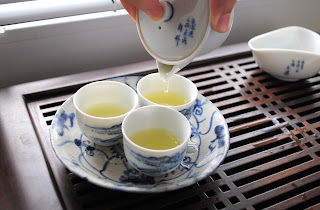 Gyokuro
Gyokuro is a fine type of green tea from Japan. It differs from the standard green tea known as
sencha (煎茶), because it is grown in the shade rather than the full sun. I very much enjoy this tea at lower temperatures of brewing water, which helps to reveal its well-kept little secret - the taste of meat.
 |
| Yuzamashi, water cooler |
To prepare this tea, I used a hohin, also known as a gyokuro teapot for this brewing session. Prices of gyokuro tea sets could range from 40 to 300 Euros. I got mine inexpensively at Takashimaya and paid slightly under 50 Euros for it. A good bargain, given the soft beautiful strokes of blue-white painting and calligraphy on my tea set.
Gyokuro leaves are rather similar in shape and form to their sencha cousin. The most noticeable difference you see here is its colour. Gyokuro leaves are generally darker as a result of spending 3 weeks under shaded conditions prior to harvest. The dried leaves smell fresh and at the same time carry a deep secondary scent of seaweed and mellowness. I could not resist the idea of picking a few leaf needles to munch on.
 |
| Hohin, gyokuro teapot |
After bringing water to the boil and filling up my hohin, I transferred water into the cooler, Yuzamashi, before transferring the same water into small cups. The idea is to cool the water down sufficiently before the infusion process begins.You can read more about the preparatory steps
here.
Meanwhile, I added about one and a half teaspoons of tea leaves to the pot and poured water from the cups into it. For the first infusion, I would allow 60 seconds before pouring the tea. This is a slow, yet rewarding process. So precious is the tea that the Japanese name it jade-coloured dew, 玉露. This tea comes from the Uji district, one of the oldest gyokuro-producing regions in Japan. However, the greatest appellation of gyokuro is Yame,
in Fukuoka Prefecture in terms of both quality and quantity.

To ensure equal concentrations in the cups, I would pour tea in the sequence of cups 1,2,3 and cups 3,2,1. This way, the more concentrated tea at the bottom of the pot will be evenly distributed. A neat little trick for the serious connoisseurs.
The jade green liquor and the mellow grassy scents emanating form the cups remind me of the misty Uji tea fields in light rain. Even though this isn't most people's idea of beautiful weather, such conditions are crucial to the quality of the next tea harvest. Tea plants thrive in high mountainous areas where the fresh misty air continues to caress and care for them.

The first infusion of gyokuro is always the strongest in terms of tasty, meaty notes. This pleasant savoury taste ('Umami', a loanward from Japanese) likens ripened tomatoes. Drinking this tea induces salivation and a furry sensation on the tongue, stimulating one's palates and throat.
Having spent 3 weeks shielded from the sun causes amino acids and caffeine in the tea leaves to build up, while catechins (the source of bitterness in tea, along with caffeine) decrease, giving rise to a deeper, richer and sweeter savoury taste.
So far, I cannot think of a more rewarding experience for a trek through the Uji mountains than this fine and exquisite tea which is a gift from the dewy skies overlooking beautiful Uji.






